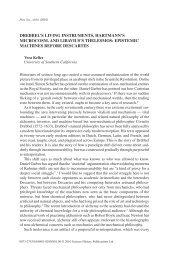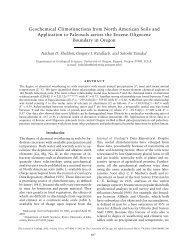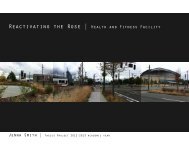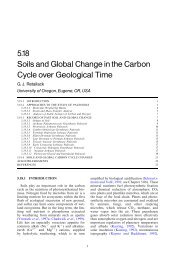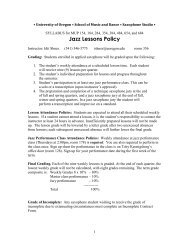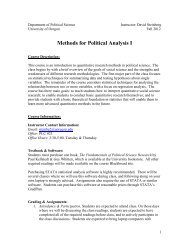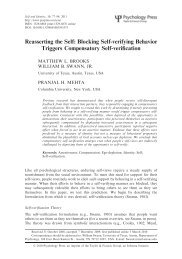16 Soils and Global Change in the Carbon Cycle over Geological Timecm0Field observationsClaySiltSandGravelOrganic Al 2 O 3δ 13 C carbonPDBCaO+MgO+Percentorganic (‰) (%) Na 2 O+K 2 O Ba/Sr grain size−35 −25 −15 0.1 0.5 1 3 5 0 5 10 0 50 100ASandBtClay50John clay paleosol100CSilt150Trough cross bedding Wavy bedding Planar bedding Woody root traces BurrowFigure 11 Geochemical (isotopic, major, and trace element) and petrographic (point count) data for adeeply weathered paleosol which formed at a latitude <strong>of</strong> 701 S in the Allan Hills <strong>of</strong> Antarctica during theEarly Triassic. This is the John paleosol, an Ultisol (Sombrihumult), as indicated especially by its highratios <strong>of</strong> alumina to bases and barium to strontium, and its strong subsurface enrichment in clay. Extremelylight carbon isotopic values deep in the pr<strong>of</strong>ile imply a role for methanogenic methane in thispostapocalyptic greenhouse. Reproduced by permission <strong>of</strong> Geological Society <strong>of</strong> America from Krull and<strong>Retallack</strong> (2000).paleolatitudes <strong>of</strong> 65–771 S (<strong>Retallack</strong> andKrull, 1999). Comparable modern soils areUltisols (Soil Survey Staff, 1999) and Acrisols(FAO, 1988), which are not found eithernorth <strong>of</strong> 481 N latitude or south <strong>of</strong> 401 S, andare rare outside subtropical regions. Greenhouseconditions at this time are also indicatedby stomatal index studies <strong>of</strong> fossil seed ferns(<strong>Retallack</strong>, 2001b) and the isotopic composition<strong>of</strong> carbon and oxygen in marine andnonmarine carbonate and organic matter(Holser and Scho¨ nlaub, 1991).The timing and magnitude <strong>of</strong> this greenhouseand isotopic excursion immediately at and afterthe greatest mass extinction <strong>of</strong> all time hassuggested a catastrophic release <strong>of</strong> methanefrom permafrost or marine clathrate deposits(Krull and <strong>Retallack</strong>, 2000; Krull et al., 2000).There is no other source <strong>of</strong> carbon that is sufficientlylarge and isotopically depleted to createthe observed negative carbon isotopic anomaly.Release mechanisms for methane could haveincluded meteorite impacts, Siberian Traps volcanism,or continental shelf collapse, which alsohave been invoked as causes for extinctions atthis time (Hallam and Wignall, 1997). Reallylarge life crises were also times <strong>of</strong> transientglobal greenhouses indicated by stomatal indexdata (<strong>Retallack</strong>, 2001b) at the earliest Jurassic(Pliensbachian), Early Jurassic (Toarcian),Mid-Jurassic (Bathonian), Early Cretaceous(Aptian), Mid-Cretaceous (Cenomanian–Turonian),earliest Paleocene (Danian), and earliestEocene (Ypresian). During the Early Mesozoic,atmospheric CO 2 minima also were high (atleast twice that <strong>of</strong> the present), and this generaland long-term greenhouse calls for a differentand noncatastrophic explanation. Paleosols andpermineralized wood <strong>of</strong> forest ecosystems athigh latitudes provide evidence for this longtermgreenhouse during which no periglacialpaleosols are recorded (Ollier and Pain, 1996;
<strong>Retallack</strong>, 2001a). The Triassic appearance <strong>of</strong>large sauropod dinosaurs such as Massospondylusand Plateosaurus, together withfootprints and other dinoturbation (Lockley,1991), and <strong>of</strong> a variety <strong>of</strong> termite and ant nestsin paleosols (Hasiotis and Dubiel, 1995), wouldhave effectively increased the destruction <strong>of</strong>woody tissues in and on soils (Olsen, 1993). Theeffect <strong>of</strong> such evolutionary innovation mayhave been to decrease carbon sequestration bylignin in swamps, forests, and their soils.5.18.3.9 Early Cretaceous Icehouse PaleosolsFossil patterned and hummocky groundreveal permafrost conditions during the EarlyCretaceous (Aptian) sediments <strong>of</strong> southeasternAustralia, which at that time was at 66–761 Sand attached to the Antarctic portion <strong>of</strong> theGondwana supercontinent (Rich and Vickers-Rich, 2000). This ice age does not appear tohave been as extensive or severe as the Permo-Carboniferous or modern ice ages. This episode<strong>of</strong> planetary cooling coincides with a dramaticevolutionary radiation <strong>of</strong> flowering plants(<strong>Retallack</strong> and Dilcher, 1986; Truswell, 1987;Crane et al., 1995). The key evolutionaryinnovation <strong>of</strong> flowering plants was an abbreviatedlife cycle, in which pollination, fertilization,and germination followed one anotherin quick succession (Wing and Boucher, 1998).Early angiosperms were largely confined toweakly developed soils (Entisols) <strong>of</strong> disturbedcoastal and streamside habitats, which theycolonized and weathered more rapidly than associatedconifers and cycadlike plants (<strong>Retallack</strong>and Dilcher, 1981). Angiosperm leaveswere less coriaceous and less well defended withresins and other toxins, and so rotted morerapidly to create a richer soil humus than leaves<strong>of</strong> conifers and cycadlike plants (Knoll andJames, 1987). Erosion control and soil humificationfrom newly evolved angiosperms mayhave played a role in Early Cretaceous chilling.5.18.3.10 Cretaceous–Paleogene GreenhousePaleosolsAnother long period <strong>of</strong> generally warmerplanetary climates without evidence <strong>of</strong> polar icecaps or periglacial paleosols lasted from theMid-Cretaceous to the latest Eocene. Mid-Cretaceous(Cenomanian) tropical paleosols (Ultisolsand Oxisols) are known from SouthAustralia, then at 601 S (Firman, 1994), andthe United States, then at 451 N(Thorp andReed, 1949; Joeckel, 1987; Mack, 1992). TheRecord <strong>of</strong> Past Soil and Global Change 17mid-Cretaceous greenhouse was unusually longand pr<strong>of</strong>ound, judging from the stomatal index<strong>of</strong> fossil ginkgo leaves (<strong>Retallack</strong>, 2001b). Volcanicactivity that created the enormous Ontong–JavaPlateau has been cited as a cause forthis long-term greenhouse (Larson, 1991), butthere is another plausible explanation in theco-evolution with angiosperms <strong>of</strong> ornithopoddinosaurs such as Iguanodon, with their impressivedental batteries for processing largeamounts <strong>of</strong> foliage. The feeding and tramplingefficiency <strong>of</strong> these large, newly evolved dinosaursmay have further promoted the spread <strong>of</strong>early angiosperms with their ability to toleratehigher levels <strong>of</strong> disturbance than other plants(Bakker, 1985). Newly evolved ornithopod dinosaursand their trackways are associatedwith carbonaceous and early successionalpaleosols (Entisols, Inceptisols, and Histosols),whereas archaic sauropod dinosaurs and theirtrackways remained associated with less fertileand less carbonaceous paleosols (Aridisols)throughout the Cretaceous (<strong>Retallack</strong>, 1997c).Other times <strong>of</strong> unusually extensive tropicalpaleosols were the latest Paleocene (55 Ma;Taylor et al., 1992), latest Eocene (35 Ma; Bestlandet al., 1996; <strong>Retallack</strong> et al., 2000), andMiddle Miocene (16 Ma; Schwarz, 1997). Theseevents are notable as short-lived (o0.5 Myr)spikelike warmings in both stable isotopicrecords from the ocean (Veizer et al., 2000;Zachos et al., 2001) and stomatal indexstudies (<strong>Retallack</strong>, 2001b). The latest Paleocenewarm spike is associated with such pr<strong>of</strong>oundcarbon isotopic lightening that it can onlyreasonably be attributed to the methane fromisotopically light methane clathrates fromocean floor sediments, permafrost, or volcanicintrusion (Koch, 1998). Short-term physicalforcings are thus also recorded in the paleosolrecord <strong>of</strong> paleoclimate.5.18.3.11 Neogene Icehouse PaleosolsPeriglacial paleosols appear during Late Miocenetime (8 Ma) in Antarctica (Sugden et al.,1995; <strong>Retallack</strong> et al., 2001), where soildevelopment is so slow that some surface soilsmay be <strong>of</strong> comparable antiquity (Campbell andClaridge, 1987). Antarctic soil formation is notonly promoted by ground ice deformation, butincludes the effects <strong>of</strong> salt accumulation andeolian mass addition in an extremely dry continentalfrigid climate (Figure 12).The Late Miocene is best known for theMessinian salinity crisis, when the MediterraneanSea became a desert (Krijgsman et al.,1999). It was also a significant time for geographicand climatic expansion <strong>of</strong> grassland



